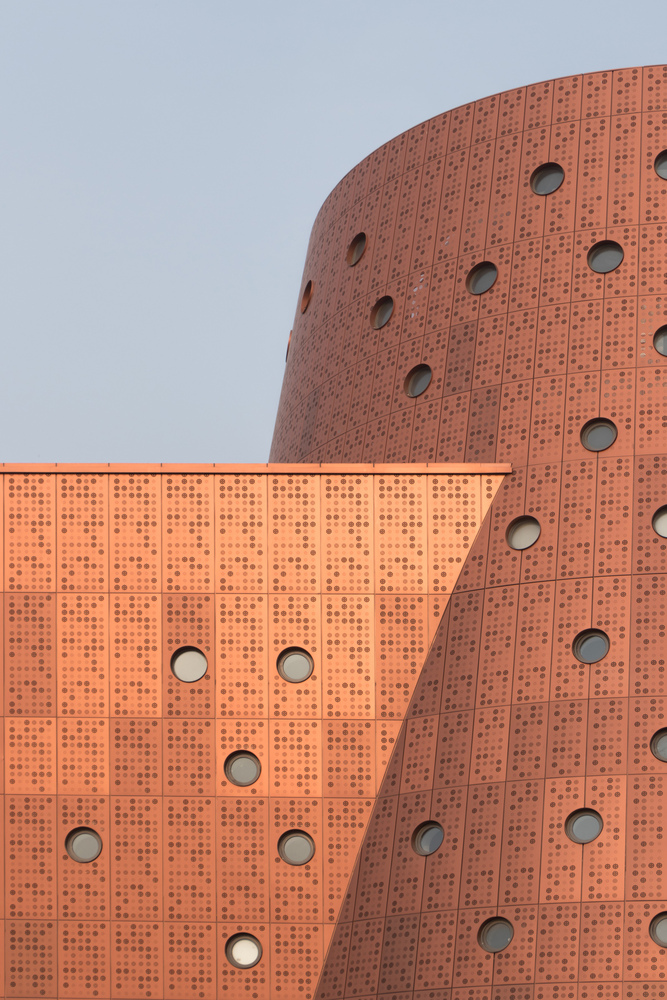Divergence House FOS
2014-06-11 01:00
© Teerawat Winyarat
c Teerawat Winyarat


架构师提供的文本描述。位于曼谷外派地区中心的一个现有的茂密花园内,“发散屋”的出现是为了尽可能多地保护该地点内现有的树木。因此,这个项目的问题不在于如何设计从外部被明确看到的房子,而在于如何将内部空间与自然环境无缝地融合在一起,使之仍能吸引人的家庭氛围。
Text description provided by the architects. Situated inside an existing lush garden in the middle of one of Bangkok's expatriate areas, Divergence House emerges from the intention of preserving as many existing trees as possible within the site. Therefore the question of this project is not so much about how to design a house being seen explicitly from outside, but rather about how to seamlessly converge the internal spaces with the natural setting in a way that it still captivates a sense of domestic atmosphere.
Floor Plan


为了将房屋内部空间与当前设置的空间融合起来,推导出透气性的概念作为基本的设计策略。所有的节目都从战略上相互分离,并精确地定位在树木之间。它们的位置取决于隐私和内部连接的程度。例如,门厅和起居空间位于前面。餐厅和具有光纤照明效果的游泳池位于隐蔽的区域,而所有的卧室都在上层。
In order to fuse the internal spaces of the house with the space of the current setting, the concept of permeability is derived as a fundamental design strategy. All the programmes are strategically diverged from one another and positioned precisely between the trees. Their locations depend on the level of privacy and internal connectivity. For instance, a foyer and a living space are located at the front. A dining room and a swimming pool with fiber-optic lighting effect are at the secluded zone while all bedrooms are on the upper level.
© Teerawat Winyarat
c Teerawat Winyarat


为了完成住宅的整体空间组织,植入了曲流循环系统,将所有主要功能连接在一起。流通系统在引导居民穿越空间中起着战略性的作用,内部和外部的空间模糊性在其中显现出来。作为这一战略的结果,一系列由架桥通道不规则形成的空隙穿透了房屋的上下两层,并垂直地将空间从地球到房屋中间连接到天空,使现有的大树能够与其居民生活在一起。(鼓掌)
To complete the whole spatial organization of the house, the system of meandering circulatory elements is implanted in order to link all the main functions together. The circulation system also plays a strategic role in leading its residents to traverse in-between spaces, in which the spatial ambiguity between inside and outside emerges. As a consequence of this strategy, series of voids, shaped irregularly by the bridging passageways, pierce the lower and upper floors of the house and vertically link the space up from the earth through the middle of the house to the sky, allowing the existing big trees to live on alongside their inhabitants.


地块内季节性低洪水也在概念化房屋的物理性方面起到了一定的作用。一楼略高于地面,以躲避洪水,并在建筑物下面留下一条清澈的通道,以供自然通风。柱基,房屋和泥土之间的物理连接,被视为湿地中红树林交错的球根的一种轻柔的触碰。为了加强一种更接近现有自然环境的感觉,在上层的庭院空间里放置了一片漂浮的草坪,它与一棵大树在视觉上连接起来,从地面穿过菱形的空隙进入地面。(鼓掌)
Seasonal low flood within the site also plays a part in conceptualising the physicality of the house. The ground floor is raised up slightly above the land in order to escape the flood and leave a clear channel underneath the building for natural ventilation. The column bases, the physical connection between the house and the earth, are treated as a gentle touch of stilt-like interlacing aerial roots of mangroves in the wetland. In order to intensify a feeling of being closer to the existing natural setting, a floating lawn is laid down inside the courtyard space on the upper floor, in which it visually connects with a big tree that penetrates up from the earth through the diamond-shaped void.
© Teerawat Winyarat
c Teerawat Winyarat


在物质性方面,“伪装”的概念贯穿于房屋的整个表面。旧木屋原址的废弃木材被用作地板材料和底层内墙的垂直百叶窗。外墙装饰也是与相同的特征,发挥与树影,在其中完成了随机抛光深灰色水泥。为了反映自然界中常见的天然池塘的质地和颜色,选择了一种特殊类型的绿色火山石,它吸收水并产生鲜艳的颜色。(鼓掌)
In terms of materiality, the idea of ‘camouflage’ is implemented throughout the entire surfaces of the house. Reused timber preserved from the old wooden house that was formerly located on the site is utilised as a flooring material and vertical louvres of internal walls on the ground floor. The exterior wall finish is also in line with the same character by playing with the shadows of the trees, in which it is finished with randomly polished dark grey cement. In order to reflect the texture and colour of a natural pond generally found in nature, a specific type of green volcanic stone which absorbs water and produces vibrant colours is chosen for the pool surface.
© Teerawat Winyarat
c Teerawat Winyarat


































































































Architects FOS
Location Bangkok, Thailand
Category Houses
Design Team Makakrai Jay Suthadarat, Singha Ounsakul, Parinwath Yingvong
Area 600.0 sqm
Project Year 2014
Photographs Teerawat Winyarat
























